Study “Economic Impacts of Climate Changes to Hydro Power Sector in Republika Srpska – Multipurpose Hydropower System of Trebišnjica
Investor: UNDP BiH
Designers: Energoprojekt – Hidroinženjering ad. Beograd & Zavod za vodoprivredu d.o.o, Bijeljina
Time of implementation: October 2019 – June 2020
INTRODUCTION
Multipurpose system for use, organization and protection of Trebišnjica river basin – „Trebišnjica“ is one of the biggest and by configuration most complex integrated development projects in the field of waters implemented in the area of South Europe. This spatial and functionally complex project, with complex target structure, often referred in short as „ Hydro Power Plants on Trebišnjica (HET)“ was leader of development and key initiator of development trends in East Herzegovina, Republika Srpska and Bosnia and Herzegovina.
Multipurpose system „Trebisnjica“ (Figure 1) – as integrated development project represent system of very complex configuration, which goes through gradual and permanent development. Present configuration of the system is implemented in several phases and stages, but some of the key objects of II and III phase are not implemented („Upper Horizons“ and HE „Dubrovnik 2“), but are very significant for completing strategy of water use for electricity production, fulfilling requirements of other beneficiaries and flood protection.
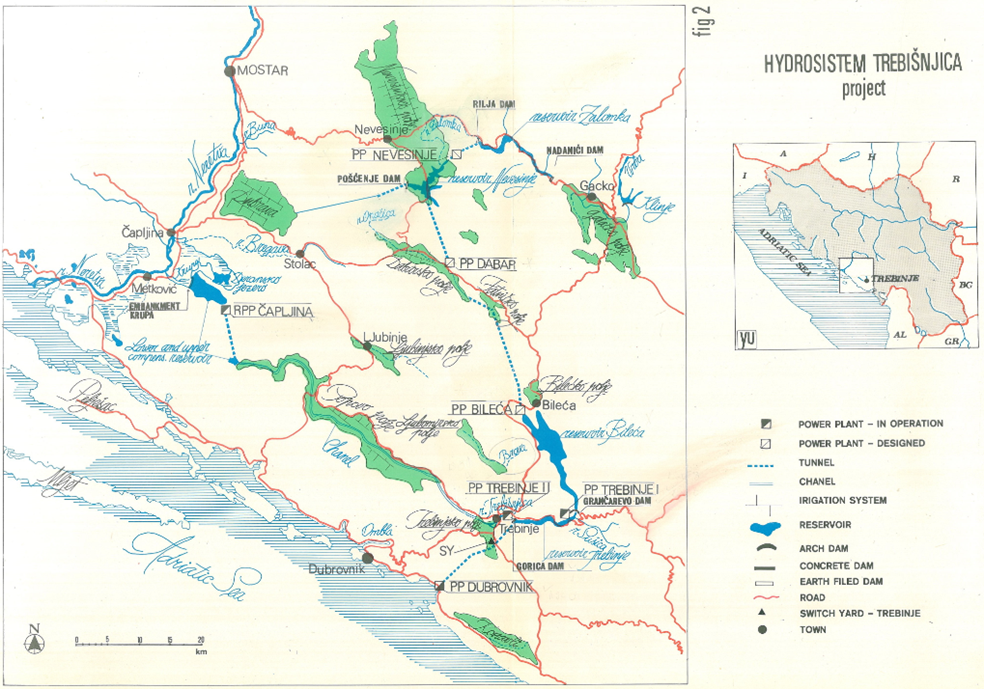
This status, where foreseen effects cannot be completely valorised indicate their shortcomings in several segments, especially during production of electricity and flood protection. Due to that it is necessary to review climate change effects to electricity production, for existing status and status when key foreseen objects are constructed, which provide power stability and functionality of integrated multipurpose hydropower system „Trebisnjica“.
Key limitations of currently constructed objects and effects of production reduction including limitations based on system development and impacts of climate changes are basic arguments defining required upgrading of system with foreseen hydro power objects. This is completing efficiency of hydropower system on all bases and fulfilling previously set system goals in complex target structure.
Study consists of 4 reports:
- I Report : Basic hydrological analyses for period 1946-2018
- II Report: Basic hydrological analyses of climate changes effects on the area of Trebisnjica hydro system
- III Report: Analyses of climate changes impacts on electricity production
- IV Report: Economic valorisation of results
Based on the new information, the Study covered also analyses of balance (Report III), respecting use of modern irrigation modules, including total requirements of one of the most important users from Bileća reservoir, that is irrigation of perspective areas in BiH and Croatia. Reviewing quantities of water for the irrigation needs is significant from the aspect of calculation of energetic valorisation of hydro power plants.
Except for water management, Bileća reservoir is key element for energy and other water and land users. It is located in waterproof area, it has huge useful volume and significant energetic value implemented on based on the drop of 350 to 400 m. This reservoir has special advantage also considering the aspect of use of Upper Horizons waters for which, considering dynamics between precipitations and runoff, it does not have sufficient accumulation abilities. In that sense, Bileca reservoir is analysed in details from the aspect of climate changes effects.
Important specific feature of the Trebisnjica system is disunity and organizational division. System elements are located in the two states and two power utilities. Significant technological interconnection of all elements, in regard to management, requires unique approach based on the profit of entire system without considering its further disbursement. Logical solution is unique management system of entire basin.
Impacts of climate changes on such scattered system can be various. They are not the same for high seasonal and small, daily-weekly accumulations. Also, they are not the same for objects with high drop („Dabar“ HPP, „Dubrovnik“ HPP) and objects with significantely less drop (“Bileća” HPP)
Considering the system of hydro power plants on Trebisnjica as integrated development project of Eastern Herzegovina which requires significant funds to be invested and from which significant incomes are expected, not just in economic sphere, it would be wise to consider impacts of expected changes in wider sense (market, range of services, development and social aspects etc.). In that sense this study covers part of stated issues which refers to impacts of expected climate changes to one such large system in regard to physical and in certain measure, economic indicators, with the basic goal to reconsider trend, and within limits of available basis, to quantify effects to physical and economic indicators of system functioning.
The energy analyses within this Study included the overview of trends and the quantification of changes of physical values (discharges, precipitations, production, and power) and technological aspect which is defining sequence of foreseen objects implementation.
CONCLUSIONS FROM THE STUDY
Water management analyses
Water permit no. 04-922-2/62 of 22.09.1962 indicates area for water management use – perspective irrigation of 11.830 ha in B&H (Republic of Srpska and Federation B&H) and Republic of Croatia and volume that should be reserved for irrigation purposes of V= 100,09 x 106 m3/year, respecting economic and other requirements with compensation of those quantities to hydropower system.
Study has identified real surface for irrigation in B&H (Repubic of Srpska and Federation B&H) and Republic of Croatia (table 1 and Figure 2).
Table 1: Real perspective surfaces for irrigation with basic data
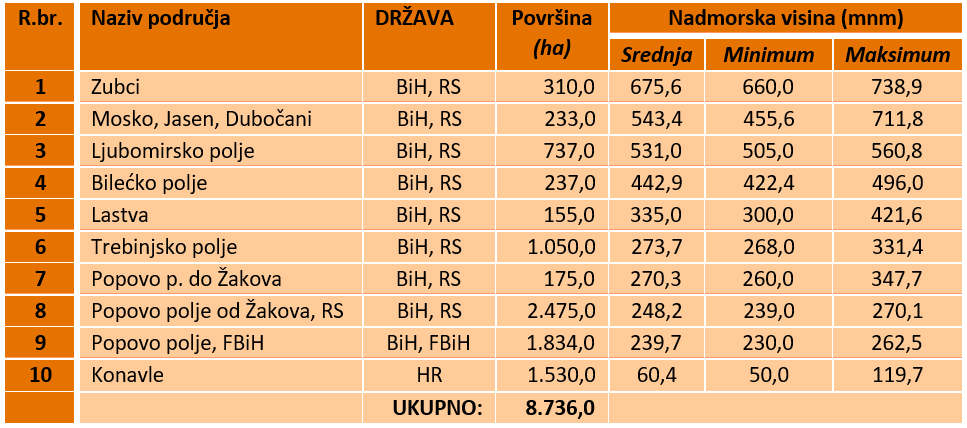
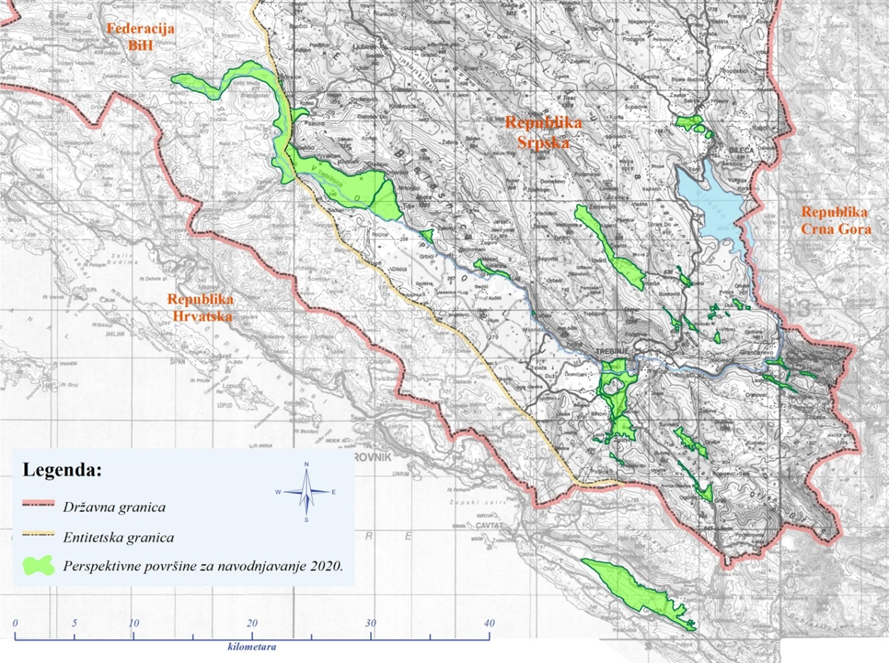
If realistically considered, perspective surfaces for irritation on wider area of Bileća, Trebinje, Trebinjsko and Popovo polje in Republika Srpska and Federation BiH and in Konavle (Republic of Croatia) are adopted for calculation of reservation in Bileća reservoir, these surfaces are for c/a 26,15 % less than those suggested for analyses from the 1962 Water permit it means 8.736 ha.
Beside this, in Bosnia and Herzegovina, perspective irrigation can be achieved on the surface of 7.206 ha, and in the area of Konavle in Republic of Croatia on 1.530 ha. If, similar to previous case, it is agreed to request “reservation” of necessary water volume for prospective dry year with return period of 5 years, we come to required volume for irrigation of:
- For the area of Bosnia and Herzegovina: Vn= 7 206 ha x 4 820 m3/ha = 34,73 x 106 m3
- For the area of Croatia: Vn= 1 530 ha x 6 560 m3/ha = 10,04 x 106 m3
What in total creates volume of:
Vn= 44,7 x 106 m3, of required annual volume for irrigation for the prospective dry year.
Additional analyses of the area are presented as permanently realistically reviewed status of possibilities of perspective irrigation development. Indicated surfaces should be harmonized between competent institutions within water sectors of Republika Srpska, Federation BiH and Republic of Croatia, as well as Beneficiaries of three Power utilities which manage the hydro power systems.
Considering the importance of agricultural production and potential development in the area with lower quality class, adopted values for the irrigation surfaces are from the 1962 water permit and new total annual water volumes according to analyses in this document in amount of Vn= 66,4 x 106 m3.
Power analyses
Power analyses covered existing and foreseen status of “Trebisnjica” HPP system. Existing system of Trebisnjica HPP consists of:
- Trebinje 1 HPP with Bileća reservoir
- Dubrovnik HPP with Trebinje reservoir
- Trebinje 2 HPP with Trebinje reservoir
- Čapljina pump HPP
In Trebisnjica river basin there are several karst fields which are flooded during flood water periods (high precipitations and flows) from the autumn till spring, and during the summer they are dry without permanent watercourses (Figure 3). Layout of foreseen and implemented objects generally covered with the Lower Horizons (blue frame) and the area of foreseen Upper Horizons (red frame – figure 4) represents implementation of the complete system.
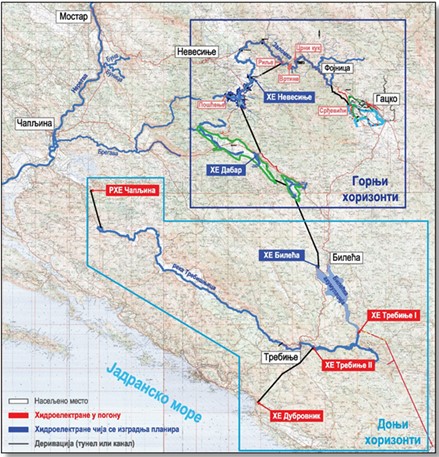
Development of foreseen objects of the system means construction of the following:
- „Dubrovnik” HPP, extension
- „Dabar” HPP, Upper Horizons – under construction
- „Nevesinje” HPP, Upper Horizons,
- „Bileća ” HPP.
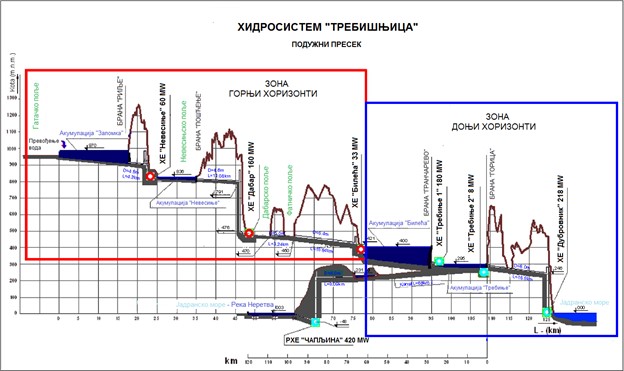
On the basis of performed analyses and power calculations following can be concluded:
- There are climate changes effects to the expected air temperature level as well as to the precipitation level in future.
- There are also precipitation and increased air temperature impacts to the runoff levels. Therefore, effects of increased temperatures are manifested by increase of evaporation from the reservoirs surface and precipitation impacts are manifested twofold:
- Impacts to the entire basin and
- Direct impacts to the reservoir surface.
- Impacts of evaporation and direct precipitation achieve opposite effects in the water balance. Therefore, impacts of direct precipitation exceed evaporation impacts, and total evaporation and direct precipitation impacts in reservoirs are below 1% inflow,
- Impacts of increased runoff in the closer and further forecast period are symbolically different (9,1 % and 9,2 %).
- Climate changes impacts to the HPP production level is defined, mostly, by expected increase of runoff.
- Power effects of climate changes to possible production of HPP is defined by difference between production in considered (closer) and referent period, is proportional to the outflow increment.
- Difference between relative increase of possible production and outflow are consequence of power features of HPPs and position in the basin.
- Evaporation from reservoir and direct precipitations in reservoir practically have no impacts to power effects of climate changes.
- Total level of power effects, as consequence of climate changes, on Trebisnjica river basin is positive and amounts to 252 GWh and climate changes impacts to the available power of HPPs does not exist.
- There is clearly expressed technological interest for further development of HPP system in the Trebisnjica basin, and in that sense, logical order for construction of objects.
- In technological sense, there is logical method of management over such system based on unique interest of profit maximisation.
Economic analyses
According to Strategy for power sector development in Republika Srpska by 2030, power sector is strategic sector for the total RS economy development. Repubika Srpska has great potential for development of this sector in sense of significant but insufficiently developed hydro power potential, first of all. Total technically usable hydro power potential of Republika Srpska amounts to 3.351,69 MW of installed power and 9.962,66 GWh of average electricity production. Trebisnjica river basin creates almost quarter of the total technical potential.
In present status c/a 2.985,8 GWh/year is used, and that makes 30% of the total potential.
Table 2: Presently used power potential of RS Power Utility
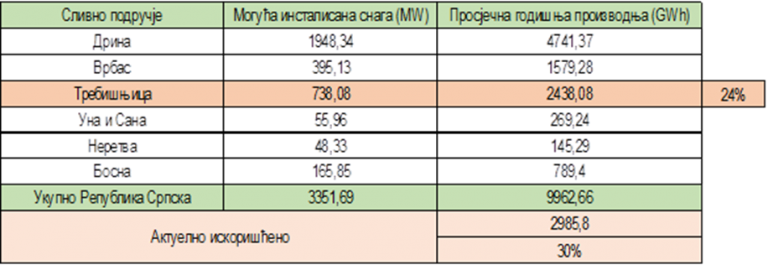
Within economic valorisation, scenarios of climate changes effects to the existing objects (“Trebinje 1” HPP with Bieća reservoir, „Dubrovnik 1” HPP with Trebinje reservoir, „Trebinje 2” HPP with Trebinje reservoir and „Dabar” HPP) and to the future objects („Dubrovnik 2” HPP, „Bileća” HPP and „Nevesinje„ HPP). Study presents status with assumed implemented “Dabar” HPP. Reason for this is since decision on construction was made and implementation is in progress.
Period 1961-1990 was adopted as basic, referent state and impacts were observed compared to it, since future closest period 2021-2050 was considered as period where impact of climate changes to the level and structure of possible production was considered.
In the close period, positive impacts of climate changes to the average annual production for the basic state in amount of 162,2 GWh was assessed, i.e. increase of average production of 7% annually.
Effects of foreseen objects are supplemented with those effects which, by implementation of first are achieved on existing object. This refers to effects of implementation of “Nevesinje” HPP regarding transfer of waters from Gatačko polje and impacts to increased production on “Dabar” HPP and “Bileća” HPP. For valorisation of effects of “Dubrovnik” HPP, effects on “Trebinje” 1 and 2 are included, in sense of increasing /reducing the production and in increasing the quality of operation of existing “Dubrovnik 1 HPP what implies the increase of achieved average annual income. From the aspect of climate changes impacts in the close period, to production effects of foreseen objects are estimated as positive, i.e. by increase of average annual production in amount of 58,4 GWh, it is increase of 11,8% compared to reference status, and the consequence of that is increase of average annual income.
Indicators of intern rate of return and net present value of investment into foreseen objects, beside evident positive impacts of climate changes, increase of IRR and NPV for all analysed objects, is reopening question regarding implementation of “Nevesinje” HPP with Zalomka reservoir with the level of the normal backwater 970 m a.s.l. Namely, this multipurpose and water management objects, whose economic sustainability is presented within the project Actualisation and updating of Preliminary design for Nevesinje HP with feasibility study, Energoprojekt - Hidroinženjering, 2018, in a way that effects, beside energetic, include those regarding effects from irrigation and water supply, from financial aspect is opening the issue if the power sector, as secondary user, can bear costs of investment by itself.
For observed existing and foreseen power plants within Trebisnjica river basin as unity, effects of climate changes in near future, from the energetic aspect, respecting the requirement of priority user-water supply, is estimated positively in sense of increase of average annual production for 220,6 GWh, what represents increase of 7,8% compared to referent condition. Increase of flow and production, will cause growth of average annual income. Having in mind fixed character of capital and almost all operational costs, for hydro power plants, additional income can be conditionally considered and additional business income and it will reflect in profitability and solvency of existing and foreseen objects. In the table further in text, summary of estimated effects for Trebisnjica HPP entirely (existing and foreseen objects).
Hydro power plants in Trebisnjica basin can participate in system services and cold reserve services in hydropower system or on stock market. In present situation there is surplus of production capacities in neighbourhood therefore prices for services are low. Besides, there is no market for cold reserve. Entering the system of renewable resources (characterised by huge unavailability of primary energy source) all the European power utilities and all the states have accepted it for reducing the greenhouse effects, will raise the issue of reserve capacities. The issue of settling the shortage of primary energy source in renewable energy sources will be especially significant. It will generate requirement for longer engagement of reserve what, beside available power also means availability of energy for those requirements. Hydro power plants in Trebisnjica river basin can provide those requirements in quite percentage.
Climate changes effects to Trebisnjica hydro power plant are presented as additional produced power. Effects regarding services and increasing the power, quality of produced energy, depend solely on construction of foreseen systems and are not subject to climate changes effects.


